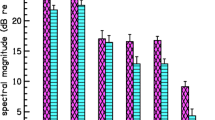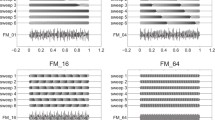Abstract
In order to structure the sensory environment our brain needs to detect changes in the surrounding that might indicate events of presumed behavioral relevance. A characteristic brain response presumably related to the detection of such novel stimuli is termed mismatch negativity (MMN) observable in human scalp recordings. A candidate mechanism underlying MMN at the neuronal level is stimulus-specific adaptation (SSA) which has several characteristics in common. SSA is the specific decrease in the response to a frequent stimulus, which does not generalize to an interleaved rare stimulus in a sequence of events. SSA was so far mainly described for changes in the response to simple pure tone stimuli differing in tone frequency. In this study we provide data from the awake rat auditory cortex on adaptation in the responses to frequency-modulated tones (FM) with the deviating feature being the direction of FM modulation. Adaptation of cortical neurons to the direction of FM modulation was stronger for slow modulation than for faster modulation. In contrast to pure tone SSA which showed no stimulus preference, FM adaptation in neuronal data differed sometimes between upward and downward FM. This, however, was not the case in the local field potential data recorded simultaneously. Our findings support the role of the auditory cortex as the source for change-related activity induced by FM stimuli by showing that dynamic stimulus features such as FM modulation can evoke SSA in the rat in a way very similar to FM-induced MMN in the human auditory cortex.





Similar content being viewed by others
References
Abolafia JM, Vergara R, Arnold MM, Reig R, Sanchez-Vives MV (2010) Cortical auditory adaptation in the awake rat and the role of potassium currents. Cereb Cortex 21:977–990
Alho K (1995) Cerebral generators of mismatch negativity (MMN) and its magnetic counterpart (MMNm) elicited by sound changes. Ear Hear 16:38–51
Altmann CF, Gaese BH (2014) Representation of frequency-modulated sounds in the human brain. Hear Res 307:74–85
Altmann CF, Klein C, Heinemann LV, Wibral M, Gaese BH, Kaiser J (2011) Repetition of complex frequency-modulated sweeps enhances neuromagnetic responses in the human auditory cortex. Hear Res 282:216–224
Anderson LA, Christianson GB, Linden JF (2009) Stimulus-specific adaptation occurs in the auditory thalamus. J Neurosci 29:7359–7363
Antunes FM, Nelken I, Covey E, Malmierca MS (2010) Stimulus-specific adaptation in the auditory thalamus of the anesthetized rat. PLoS One 5(11):e14071. doi:10.1371/journal.pone.0014071
Astikainen P, Stefanics G, Nokia M, Lipponen A, Cong F, Penttonen M, Ruusuvirta T (2011) Memory-based mismatch response to frequency changes in rats. PLoS One 6(9):e24208. doi:10.1371/journal.pone.0024208
Bäuerle P, von der Behrens W, Kössl M, Gaese BH (2011) Stimulus-specific adaptation in the gerbil primary auditory thalamus is the result of a fast frequency-specific habituation and is regulated by the corticofugal system. J Neurosci 31:9708–9722
Brosch M, Schreiner CE (1997) Time course of forward masking tuning curves in cat primary auditory cortex. J Neurophysiol 77:923–943
Duque D, Pérez-González D, Ayala YA, Palmer AR, Malmierca MS (2012) Topographic distribution, frequency, and intensity dependence of stimulus-specific adaptation in the inferior colliculus of the rat. J Neurosci 32:17762–17774
Escera C, Alho K, Winkler I, Näätäen R (1998) Neural mechanisms of involuntary attention to acoustic novelty and change. J Cogn Neurosci 10:590–604
Farley BJ, Quirk MC, Doherty JJ, Christian EP (2010) Stimulus-specific adaptation in auditory cortex is an NMDA-Independent process distinct from the sensory novelty encoded by mismatch negativity. J Neurosci 30:16475–16484
Felsheim C, Ostwald J (1996) Responses to exponential frequency modulations in the rat inferior colliculus. Hear Res 98:137–151
Fishman YI, Steinschneider M (2012) Searching for the mismatch negativity in primary auditory cortex of the awake monkey: deviance detection or stimulus specific adaptation? J Neurosci 32:15747–15758
Gaese BH, King I, Felsheim C, Ostwald J, von der Behrens W (2006) Discrimination of direction in fast frequency-modulated tones by rats. J Assoc Res Otolaryngol 7:48–58
Gaese BH, Ostwald J (2001) Anesthesia changes frequency tuning of neurons in the rat primary auditory cortex. J Neurophysiol 86:1062–1066
Grimm S, Escera C (2011) Auditory deviance detection revisited: evidence for a hierarchical novelty system. Int J Psychophysiol 85:88–92
Heinemann LV, Rahm B, Kaiser J, Gaese BH, Altmann CF (2010) Repetition enhancement for frequency-modulated but not unmodulated sounds: a human MEG study. PLoS One 5:e15548. doi:10.1371/journal.pone.0015548
Huotilainen M, Winkler I, Alho K, Escera C, Virtanen J, Ilmoniemi RJ, Jääskelainen IP, Pekkonen E, Näätänen R (1998) Combined mapping of human auditory EEG and MEG responses. Electroencephalogr Clin Neurophysiol 108:370–379
Jaramillo S, Zador AM (2011) The auditory cortex mediates the perceptual effects of acoustic temporal expectation. Nat Neurosci 14:246–251
Javitt DC, Steinschneider M, Schroeder CE, Vaughan HG Jr, Arezzo JC (1994) Detection of stimulus deviance within primate primary auditory cortex: intracortical mechanisms of mismatch negativity (MMN) generation. Brain Res 667:192–200
König R, Sieluzycki C, Simserides C, Heil P, Scheich H (2008) Effects of the task of categorizing FM direction on auditory evoked magnetic fields in the human auditory cortex. Brain Res 1220:102–117
Kuo RI, Wu GK (2012) The generation of direction selectivity in the auditory system. Neuron 73:1016–1027
Lakatos P, Shah AS, Knuth KH, Ulbert I, Karmos G, Schroeder CE (2005) An oscillatory hierarchy controlling neuronal excitability and stimulus processing in the auditory cortex. J Neurophysiol 94:1904–1911
Lee CC, Sherman SM (2011) On the classification of pathways in the auditory midbrain, thalamus, and cortex. Hear Res 276:79–87
Leitman DI, Sehatpour P, Garidis C, Gomez-Ramirez M, Javitt DC (2011) Preliminary Evidence of Pre-Attentive Distinctions of Frequency-Modulated Tones that Convey Affect. Front Hum Neurosci 5:96
Liberman AM, Mattingly IG (1989) A specialization for speech perception. Science 243:489–494
Malmierca MS, Cristaudo S, Pérez-González D, Covey E (2009) Stimulus-specific adaptation in the inferior colliculus of the anesthetized rat. J Neurosci 29:5483–5493
May PJC, Tiitinen H (2010) Mismatch negativity (MMN), the deviance-elicited auditory deflection, explained. Psychophysiol 47:66–122
Näätänen R, Gaillard AW, Mäntysalo S (1978) Early selective-attention effect on evoked potential reinterpreted. Acta Psychol (Amst) 42:313–329
Nakamura T, Michie PT, Fulham WR, Todd J, Budd TW, Schall U, Hunter M, Hodgson DM (2011) Epidural auditory event-related potentials in the rat to frequency and duration deviants: evidence of mismatch negativity? Front Psychol 2:367. doi:10.3389/fpsyg.2011.00367
Nelken I, Ulanovsky N (2007) Mismatch negativity and stimulus-specific adaptation in animal models. J Psychophysiol 21:214–223
Ohl FW, Wetzel W, Wagner T, Rech A, Scheich H (1999) Bilateral ablation of auditory cortex in Mongolian gerbil affects discrimination of frequency modulated tones but not of pure tones. Learn Mem 6:347–362
Paavilainen P, Jaramillo M, Näätänen R, Winkler I (1999) Neuronal populations in the human brain extracting invariant relationships from acoustic variance. Neurosci Lett 265:179–182
Pardo PJ, Sams M (1993) Human auditory cortex responses to rising versus falling glides. Neurosci Lett 159:43–45
Rutkowski RG, Miasnikov AA, Weinberger NM (2003) Characterisation of multiple physiological fields within the anatomical core of rat auditory cortex. Hearing Res 181:116–130
Sams M, Näätänen R (1991) Neuromagnetic responses of the human auditory cortex to short frequency glides. Neurosci Lett 121:43–46
Sperling G (1960) The information available in brief visual presentations. Psychological Monographs 74:1–29
Taaseh N, Yaron A, Nelken I (2011) Stimulus-Specific Adaptation and Deviance Detection in the Rat Auditory Cortex. PLoS One 6(8):e23369. doi:10.1371/journal.pone.0023369
Thomas JM, Morse C, Kishline L, O’Brien-Lambert A, Simonton A, Miller KE, Covey E (2012) Stimulus-specific adaptation in specialized neurons in the inferior colliculus of the big brown bat, Eptesicus fuscus. Hear Res 291:34–40
Timm J, Weise A, Grimm S, Schröger E (2011) An asymmetry in the automatic detection of the presence or absence of a frequency modulation within a tone: a mismatch negativity study. Front Psychol 2:189. doi:10.3389/fpsyg.2011.00189
Ulanovsky N, Las L, Nelken I (2003) Processing of low-probability sounds by cortical neurons. Nat Neurosci 6:391–398
von der Behrens W, Bäuerle P, Kössl M, Gaese BH (2009) Correlating stimulus-specific adaptation of cortical neurons and local field potentials in the awake rat. J Neurosci 29:13837–13849
Yabe H, Tervaniemi M, Reinikainen K, Näätänen R (1997) Temporal window of integration revealed by MMN to sound omission. NeuroReport 8:1971–1974
Yaron A, Hershenhoren I, Nelken I (2012) Sensitivity to complex statistical regularities in rat auditory cortex. Neuron 76:603–615
Zhang LI, Tan AYY, Schreiner CE, Merzenich MM (2003) Topography and synaptic shaping of direction selectivity in primary auditory cortex. Nature 424:201–205
Acknowledgments
The authors thank the guest editors, Drs. Valerie Shafer and Elyse Sussman, for supporting the submission of this paper to the special issue on MMN. Two anonymous reviewers provided helpful comments and suggestions on a previous version of the manuscript.
Author information
Authors and Affiliations
Corresponding author
Additional information
This is one of several papers published together in Brain Topography in the “Special Issue: Mismatch Negativity”.
Rights and permissions
About this article
Cite this article
Klein, C., von der Behrens, W. & Gaese, B.H. Stimulus-Specific Adaptation in Field Potentials and Neuronal Responses to Frequency-Modulated Tones in the Primary Auditory Cortex. Brain Topogr 27, 599–610 (2014). https://doi.org/10.1007/s10548-014-0376-4
Received:
Accepted:
Published:
Issue Date:
DOI: https://doi.org/10.1007/s10548-014-0376-4




